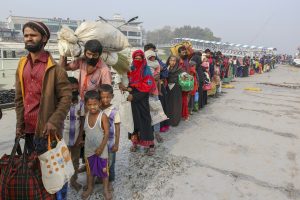One year since Bangladesh began relocating thousands of Rohingya refugees from Cox’s Bazar to Bhasan Char – a remote and cyclone-prone island in the Bay of Bengal – it’s time to take stock. While the Bangladesh government says the relocation is “imperative” to decongest the overcrowded camps in Cox’s Bazar, it undermines long-term solutions and challenges refugees’ access to basic rights. The case of Bhasan Char is linked to the concept of refugee “warehousing” – the practice of indefinitely keeping refugees in situations of restricted mobility. Such policies are increasingly in need of attention throughout the region, where Australia, Thailand, Malaysia, and others have engaged in challenging refugee reception practices.
19,000 Rohingya refugees are currently estimated to be on Bhasan Char. The island, which previously hosted a military establishment, reportedly lacks suitable infrastructure to support populations over time. It also is exposed to potential climate events. Considerable national and international steps will need to be taken in order to create routes toward solutions that ensure respect of fundamental rights, demonstrate collaborative approaches, and support the challenges faced by Bangladesh as a hosting country.
Bangladesh began housing Rohingya refugees on Bhasan Char in May 2020, after rescuing a stranded boat attempting to travel to Malaysia from Cox’s Bazar. While initially presented as a quarantine facility to prevent the spread of COVID-19 in the camps, refugees have been kept on the island since that time, with some facing arrests for attempting to leave.
In December 2020, Bangladesh authorities officially began relocating hundreds of Rohingya refugees from Cox’s Bazar to Bhasan Char, ignoring calls from the UNHCR and rights groups to allow an independent technical assessment of the refugees’ protection needs, and the safety and habitability of the island beforehand. According to local authorities, all those relocated gave consent for the move. However, media reports suggest that many received very limited information prior to relocation, and some felt coerced to move.
The UNHCR and rights groups have expressed concern that the island has limited capacity for an evacuation in the event of cyclones or other natural disasters. Many Rohingya refugees on Bhasan Char also repeatedly say they are living in “prison-like” conditions with very limited access to healthcare, education, work, and protection. However, the Bangladesh Refugee Commissioner reports the government will send some 81,000 Rohingya refugees to the island once the 2022 monsoon storms end, to fulfill a quota of 100,000. Bangladesh has simultaneously taken steps to “clear the way for new homes” in Cox’s Bazar, including the controversial demolition of over 2,000 shops in the camps, as the number of refugees increases.
Despite the considerable human rights and social implications, refugee warehousing has a long history across the globe. In Asia and the Pacific, it traces back to the Vietnam War and beyond. The economic and social consequences of warehousing are considerable, while the problems of longer-term dependency and lack of access to fundamental rights consistently present themselves in critiques. Australia’s offshore processing regime, for example, has long received condemnation for the mistreatment of people seeking international protection. Warehousing also increases risks for confined refugees during the pandemic as many immigration detention centers have become COVID-19 epicenters, as in Japan, Thailand, and Papua New Guinea.
Thus far, Bhasan Char has failed to prove an exception to the challenging record of other immigration facilities in the region. Bangladesh is not a signatory to the 1951 Refugee Convention and has not granted Rohingya refugees the rights to work, freedom of movement, education, healthcare, and family unity. The relocation further limits refugee access to durable solutions and entitlements underscored in international law.
Media reports detail an early July 2021 health crisis in which more than 5,000 Rohingya refugees suffered and at least three children died. Mental health has also suffered, as refugees remain isolated and separated from support systems, unable to travel. In a positive move, Bangladesh authorities allowed 68 Rohingya to leave Bhasan Char to visit family members in Cox’s Bazar.
Warehousing refugees on Bhasan Char has created systems of dependency on external support. While an agreement between the UNHCR and the government of Bangladesh in October 2021 opens the door to humanitarian assistance on the island, serious concerns remain as the deal offers no guarantee that Rohingya will be permitted to move freely to the mainland or engage in economic activities on Bhasan Char or contribute to the economy of Bangladesh.
In the longer term, most Rohingya refugees will likely remain in Bangladesh. The prospect of repatriation to Myanmar has dwindled following the military seizure of power there in February 2021, and challenges to onward movement to countries such as Malaysia – a destination for thousands Rohingya – are rising.
There are a number of alternatives. Regularization of the refugee population could allow for considerable Rohingya contributions to host communities across the region. At the same time, increased resettlement could ease pressures in Cox’s Bazar and Bhasan Char, as well as demonstrate global solidarity in responding to a global warehousing challenge.
The Rohingya must also be provided with legal avenues to pursue grievances in the event of abuse, harassment, and other forms of violence, and ensure their rights under Bangladeshi and international laws. Given the dynamics surrounding and prospects for Rohingya refugees, further isolating the population is counterproductive.
Without effective coordination between governments involved, the international community, and regional networks, the situation facing Rohingya refugees in Bangladesh will remain fragile.

































